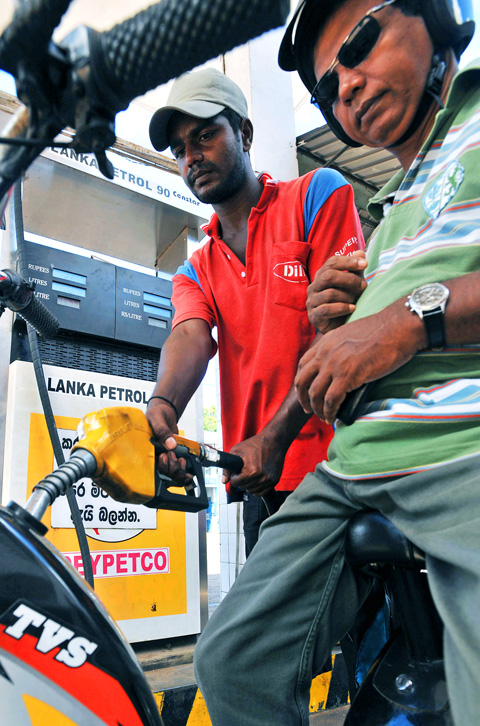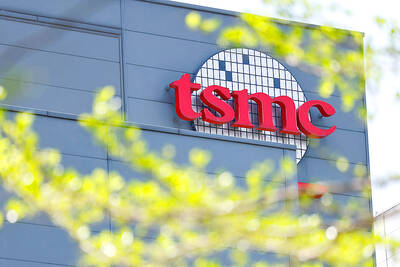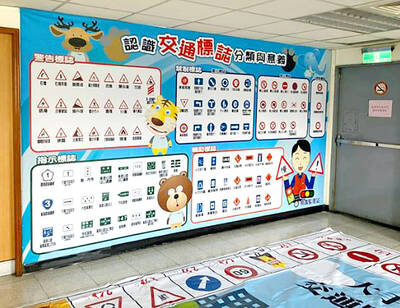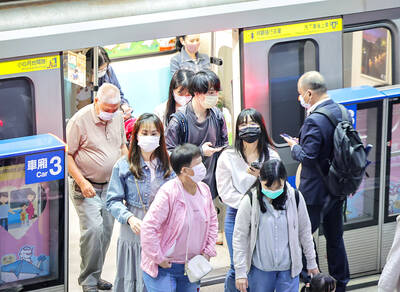Iran plans to hike domestic gas prices to encourage consumers to conserve and to help to free up supplies for export, officials said on Saturday.
“The decision is to be announced this summer or just after,” a senior government official said.
He was speaking at the third annual Ravand Institute conference, which brings together political and economic leaders and experts from Iran and abroad, and whose proceedings may only be reported under the cloak of anonymity.

PHOTO: AFP
Natural gas sells for only US$0.02 per cubic meter in Iran, compared with US$0.30 in neighboring countries, and the difference represents a subsidy of around US$40 billion a year, the official said.
The plan will be to raise the price to US$0.15 per cubic meter for industrial customers, the official said, but he did not provide a figure for individual customers.
Ironically, while Iran has the world’s second-largest reserves of natural gas, the country is a net importer because of a highly inefficient use of it in industry and profligate use on the part of private consumers.
An official from Iran’s gas sector said the country needed to economize to export, and that it is consuming too much.
But an executive from an Iranian gas company said it was ironic that with such high reserves, Iran “could not heat its houses” and forecast that “gas shortages are going to be with us for a long time.”
The senior government official said the “peak of consumption went above 500 million cubic meters a day last winter but our production did not reach that level.”
In January, Iran announced record production of only 460 million cubic meters a day.
The country has a 20-year plan aiming to hike production to 1.45 billion cubic meters a day, with 642 million earmarked for domestic consumption, 259 million for injection in oil production wells and 550 million for export.
But these projects need massive investment, hampered by a US economic boycott.
SRI LANKA
Sri Lanka raised fuel prices and Bangladesh said it planned a hike soon, the latest Asian nations to find they can no longer afford to shield consumers from soaring oil prices.
The two poor South Asian countries announced their steps to limit mounting losses at state-owned oil retailers yesterday, just a day after Indonesia raised fuel prices to cap ballooning fuel subsidies.
India, Asia’s third-largest economy and the world’s second most populous nation, is considering such a move.
Sri Lanka raised kerosene, gasoline and diesel prices by between 14 and 47 percent. In Bangladesh, the country’s state-run Bangladesh Petroleum Corp, the sole oil importer and distributor, has proposed fuel price increases of 37 percent to 80 percent.
Governments across Asia have tried to soften the impact of a global surge in food and energy prices on their populations by keeping domestic prices of fuel and food staples below international levels.
But with oil powering to fresh records almost every week, the last one above US$135 a barrel, several nations feel they can no longer fully subsidize consumers or cover soaring losses of state-controlled oil importers and retailers.
The chairman of Sri Lanka’s Ceylon Petroleum Corp said that this weekend’s fuel price increase would allow the company to only halve its losses from 175 million Sri Lanka rupees (US$1.62 million) a day.
“Even after the increase we are still in the negative ... what we have done is we basically brought it to levels that we can manage,” Ashantha de Mell said.
Oil retailer and subsidiary of Indian Oil Lanka, IOC also raised diesel and fuel prices this week.
In Bangladesh, the interim army-backed government is due to decide shortly about the oil company’s proposal.
“We are examining the proposal regarding the extent of the price hike and the decision will be taken at the highest level very soon,” said M. Tamim in charge of energy and mineral resources.
He said that without a price hike, the government would have to dish out about US$1.5 billion to cover its oil company’s losses this fiscal
RUSSIA
Russian motorists protested in several major cities on Saturday at high prices for gasoline in the world’s second largest oil exporter.
They demanded the government cut taxes on car fuel to 40 percent from 70 percent, to bring down the retail price of gasoline to 15 rubles (US$0.636) per liter (US$2.41 per gallon) from 22 rubles now.
State television showed car owners banging on empty fuel canisters and driving through city streets with their emergency lights on and posters displayed in their windscreens — a form of protest that does not require a permit.
Public protests have become relatively rare in Russia after an eight-year-long, oil-fueled economic boom and a drive by authorities to stamp out opposition and establish control over national media.
Vladimir Putin, who took over as prime minister after anointing his ally Dmitry Medvedev to succeed him as Russia’s president, enjoys high popularity ratings despite galloping inflation, which threatens to exceed 15 percent this month.

EUROPEAN TARGETS: The planned Munich center would support TSMC’s European customers to design high-performance, energy-efficient chips, an executive said Taiwan Semiconductor Manufacturing Co (TSMC, 台積電), the world’s largest contract chipmaker, yesterday said that it plans to launch a new research-and-development (R&D) center in Munich, Germany, next quarter to assist customers with chip design. TSMC Europe president Paul de Bot made the announcement during a technology symposium in Amsterdam on Tuesday, the chipmaker said. The new Munich center would be the firm’s first chip designing center in Europe, it said. The chipmaker has set up a major R&D center at its base of operations in Hsinchu and plans to create a new one in the US to provide services for major US customers,

The Ministry of Transportation and Communications yesterday said that it would redesign the written portion of the driver’s license exam to make it more rigorous. “We hope that the exam can assess drivers’ understanding of traffic rules, particularly those who take the driver’s license test for the first time. In the past, drivers only needed to cram a book of test questions to pass the written exam,” Minister of Transportation and Communications Chen Shih-kai (陳世凱) told a news conference at the Taoyuan Motor Vehicle Office. “In the future, they would not be able to pass the test unless they study traffic regulations

GAINING STEAM: The scheme initially failed to gather much attention, with only 188 cards issued in its first year, but gained popularity amid the COVID-19 pandemic Applications for the Employment Gold Card have increased in the past few years, with the card having been issued to a total of 13,191 people from 101 countries since its introduction in 2018, the National Development Council (NDC) said yesterday. Those who have received the card have included celebrities, such as former NBA star Dwight Howard and Australian-South Korean cheerleader Dahye Lee, the NDC said. The four-in-one Employment Gold Card combines a work permit, resident visa, Alien Resident Certificate (ARC) and re-entry permit. It was first introduced in February 2018 through the Act Governing Recruitment and Employment of Foreign Professionals (外國專業人才延攬及雇用法),

‘COMING MENACINGLY’: The CDC advised wearing a mask when visiting hospitals or long-term care centers, on public transportation and in crowded indoor venues Hospital visits for COVID-19 last week increased by 113 percent to 41,402, the Centers for Disease Control (CDC) said yesterday, as it encouraged people to wear a mask in three public settings to prevent infection. CDC Epidemic Intelligence Center Deputy Director Lee Chia-lin (李佳琳) said weekly hospital visits for COVID-19 have been increasing for seven consecutive weeks, and 102 severe COVID-19 cases and 19 deaths were confirmed last week, both the highest weekly numbers this year. CDC physician Lee Tsung-han (李宗翰) said the youngest person hospitalized due to the disease this year was reported last week, a one-month-old baby, who does not